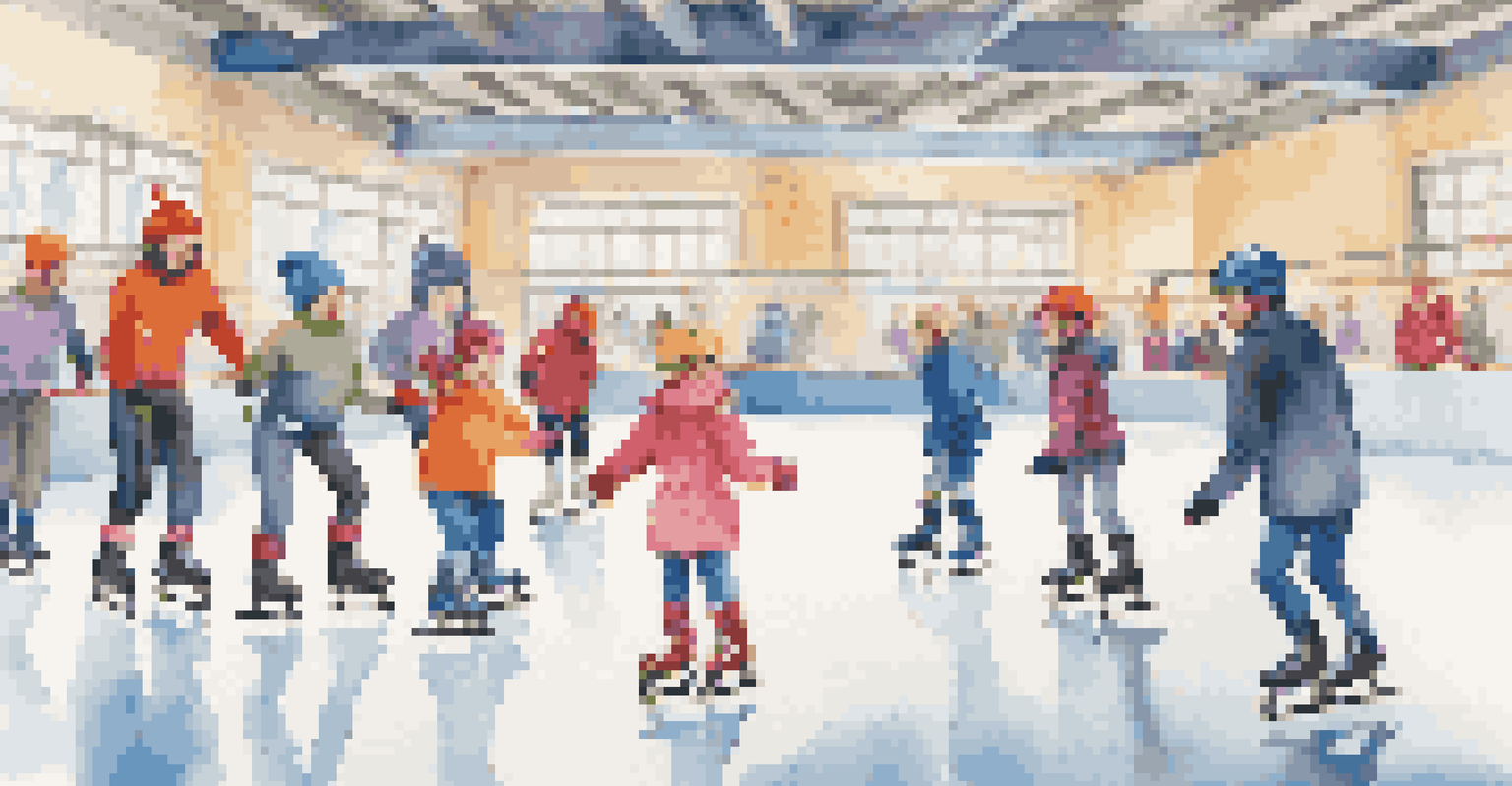Ice Skating Injuries: Prevention and Treatment Tips

Understanding Common Ice Skating Injuries
Ice skating, while exhilarating, can lead to a variety of injuries. Common issues include sprains, fractures, and bruises, primarily affecting the ankles, wrists, and knees. These injuries often stem from falls or collisions, making it critical to understand their nature to prevent them.
Safety isn't just a slogan, it's a way of life.
For instance, a sprained ankle occurs when the ligaments are stretched or torn, which can happen if you lose balance. Fractures, on the other hand, typically result from a hard fall or impact. Recognizing these injuries can help skaters take the necessary precautions.
Awareness is the first step in prevention. By knowing what kind of injuries can occur, skaters can be more mindful of their movements and surroundings on the ice.
Essential Safety Gear for Ice Skating
Wearing the right safety gear is crucial in reducing the risk of injuries while ice skating. Helmets, wrist guards, and knee pads can provide significant protection against falls and impacts. Think of safety gear as your ice skating armor, designed to keep you safe as you glide.

For beginners, a helmet is especially important, as it protects the head during falls. Wrist guards help prevent fractures and sprains, while knee pads cushion the knees during unexpected tumbles. Investing in good quality gear can make a huge difference in your skating experience.
Common Ice Skating Injuries
Ice skating can lead to injuries like sprains and fractures, often resulting from falls or collisions.
Don't underestimate the importance of proper footwear either. Well-fitted skates that provide adequate ankle support are essential in preventing foot and ankle injuries.
Warm-up Exercises to Prevent Injuries
Just like any physical activity, warming up is key to preventing injuries in ice skating. A good warm-up routine increases blood flow to the muscles and prepares your body for the demands of skating. It’s like prepping your engine before a race; a little effort can go a long way.
The only way to avoid injury is to take precautions and be aware of your surroundings.
Simple stretches targeting your legs, ankles, and back can greatly enhance flexibility and reduce the risk of strains. For example, dynamic stretches such as leg swings and arm circles can help get your body ready for action. Remember, a few minutes of warming up can protect you from hours of pain later.
Incorporating balance exercises can also improve your stability on the ice, making falls less likely. Exercises like standing on one foot or using a balance board can be particularly beneficial.
Recognizing the Signs of Ice Skating Injuries
Understanding the early signs of injury can make a big difference in recovery. Symptoms like swelling, pain, or inability to put weight on a limb can indicate a more serious issue. It's essential to listen to your body; don’t ignore these warning signs.
For instance, if you're experiencing persistent pain after skating, it might be time to take a break and assess the situation. Ignoring these signs can lead to chronic injuries that require more extensive treatment.
Importance of Safety Gear
Wearing appropriate safety gear, such as helmets and wrist guards, is essential to minimize injury risks while skating.
If you notice severe swelling or your range of motion is limited, consulting a healthcare professional is advisable. Early intervention can lead to better outcomes and a quicker return to skating.
Basic First Aid for Ice Skating Injuries
Knowing basic first aid can be invaluable when dealing with ice skating injuries. The R.I.C.E. method—Rest, Ice, Compression, and Elevation—can be your best friend in managing minor injuries. Think of it as your DIY toolkit for handling bumps and bruises.
Rest is crucial to allow your body to heal, while applying ice helps reduce swelling and pain. Compression wraps can provide support, and elevating the injured area can further reduce inflammation. These simple steps can make a significant difference in recovery time.
However, if the injury feels severe or if symptoms persist, seeking medical assistance is essential. It's better to be safe and ensure proper treatment.
When to Seek Professional Help for Injuries
Knowing when to seek professional help is vital in managing ice skating injuries effectively. If you experience severe pain, instability in the joint, or inability to bear weight, these are indicators that you should consult a healthcare professional. It’s like having a safety net; don’t hesitate to use it.
Additionally, if you notice your symptoms worsening over time or if you have recurrent injuries, a visit to a doctor or physical therapist can provide insights into underlying issues. They can help develop a tailored rehabilitation program to get you back on the ice safely.
Recognizing Injury Signs
Early recognition of injury symptoms like swelling and pain is crucial for effective recovery and preventing further complications.
Remember, addresses injuries sooner rather than later can prevent longer recovery times and more serious complications down the line.
Tips for Returning to Ice Skating After Injury
Returning to ice skating after an injury requires careful planning and patience. Gradually reintroducing skating into your routine can help your body adjust and reduce the risk of re-injury. Think of it like easing back into running after a long break; you wouldn’t sprint right away!
Start with shorter skating sessions, focusing on gentle movements before progressing to more intense maneuvers. Listening to your body is crucial; if you experience discomfort, it may be wise to take a step back. Remember, slow and steady wins the race.

Finally, consider working with a coach or trainer who can provide guidance and support as you return to the ice. They can help you build confidence and ensure your technique is sound, which can further reduce the risk of injury.